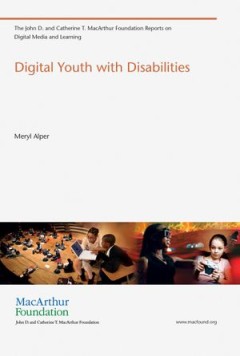Filter by

Planetary Hinterlands
This open access book considers the concept of the hinterland as a crucial tool for understanding the global and planetary present as a time defined by the lasting legacies of colonialism, increasing labor precarity under late capitalist regimes, and looming climate disasters. Traditionally seen to serve a (colonial) port or market town, the hinterland here becomes a lens to attend to the times…
- Edition
- -
- ISBN/ISSN
- 978-3-031-24243-4
- Collation
- XVI, 341
- Series Title
- -
- Call Number
- -

Updating to remain the same :habitual new media
What it means when media moves from the new to the habitual -- when our bodies become archives of supposedly obsolescent media, streaming, updating, sharing, saving.OCLC-licensed vendor bibliographic record.
- Edition
- -
- ISBN/ISSN
- 9780262333771
- Collation
- 1 online resource
- Series Title
- -
- Call Number
- -
Self-tracking
People keep track. In the eighteenth century, Benjamin Franklin kept charts of time spent and virtues lived up to. Today, people use technology to self-track: hours slept, steps taken, calories consumed, medications administered. Ninety million wearable sensors were shipped in 2014 to help us gather data about our lives. This book examines how people record, analyze, and reflect on this data, l…
- Edition
- -
- ISBN/ISSN
- 9780262334693
- Collation
- 1 online resource (xi, 233 pages) :illustrations.
- Series Title
- -
- Call Number
- -

New tendencies :art at the threshold of the information revolution (1961-1978)
An account of a major international art movement originating in the former Yugoslavia in the 1960s, which anticipated key aspects of information aesthetics.OCLC-licensed vendor bibliographic record.
- Edition
- -
- ISBN/ISSN
- 9780262331913
- Collation
- 1 online resource (x, 395 pages).
- Series Title
- -
- Call Number
- -

Being and the screen :how the digital changes perception : published in one v…
OCLC-licensed vendor bibliographic record.
- Edition
- -
- ISBN/ISSN
- 9780262355780
- Collation
- 1 online resource (240 pages).
- Series Title
- -
- Call Number
- -

Digital Youth with Disabilities
An examination of media and technology use by school-aged youth with disabilities, with an emphasis on media use at home. Most research on media use by young people with disabilities focuses on the therapeutic and rehabilitative uses of technology; less attention has been paid to their day-to-day encounters with media and technology—the mundane, sometimes pleasurable and sometimes frustrating…
- Edition
- -
- ISBN/ISSN
- 9780262527156
- Collation
- -
- Series Title
- -
- Call Number
- 362 ALP d

Reconstructions of Gender and Information Technology
This open access book explores what makes women decide to pursue a career in male-dominated fields such as information technology (IT). It reveals how women experience gendered stereotypes but also how they bypass, negotiate, and challenge such stereotypes, reconstructing gender-technology relations in the process. Using the example of Norway to illuminate this challenge in Western countries, t…
- Edition
- -
- ISBN/ISSN
- 978-981-99-5186-4
- Collation
- XV, 133
- Series Title
- -
- Call Number
- -

Alterung und Pflege als kommunale Aufgabe
Die Beiträge in diesem Open-Access-Sammelband beschreiben und analysieren aus multidisziplinärer Sicht die Herausforderungen und Bewältigungsstrategien von Alterung und Pflege in japanischen und deutschen Gemeinden. Thematisiert werden rechtliche Rahmenbedingungen, zivilgesellschaftliches Engagement, Pflegekräftemangel, Technologiekonzepte für die Pflege und schließlich auch der Einfluss …
- Edition
- -
- ISBN/ISSN
- 978-3-658-36844-9
- Collation
- -
- Series Title
- 3 b/w illustrations, 37 illustrations in colour
- Call Number
- XV, 364

Integrated Treatment Technology of Rural Domestic Sewage
This open access book provides integrated treatment technology of rural domestic sewage, and highlights ten typical cases in China. The integrated sewage treatment system (ISTE) combine sewage pretreatment, biological treatment, sedimentation, and disinfection, which particularly suitable for decentralized domestic wastewater treatment in rural areas without pipe networks. The main advantages o…
- Edition
- -
- ISBN/ISSN
- 978-981-99-5905-1
- Collation
- XIII, 140
- Series Title
- -
- Call Number
- -

Design Things
Thomas Binder, Giorgio De Michelis, Pelle Ehn, Giulio Jacucci, Per Linde, and Ina Wagner."A new perspective on design thinking and design practice: beyond products and projects, toward participatory design things.OCLC-licensed vendor bibliographic record.
- Edition
- -
- ISBN/ISSN
- 9780262298254
- Collation
- 1 online resource (xvi, 239 pages) :illustrations.
- Series Title
- -
- Call Number
- -
 Computer Science, Information & General Works
Computer Science, Information & General Works  Philosophy & Psychology
Philosophy & Psychology  Religion
Religion  Social Sciences
Social Sciences  Language
Language  Pure Science
Pure Science  Applied Sciences
Applied Sciences  Art & Recreation
Art & Recreation  Literature
Literature  History & Geography
History & Geography